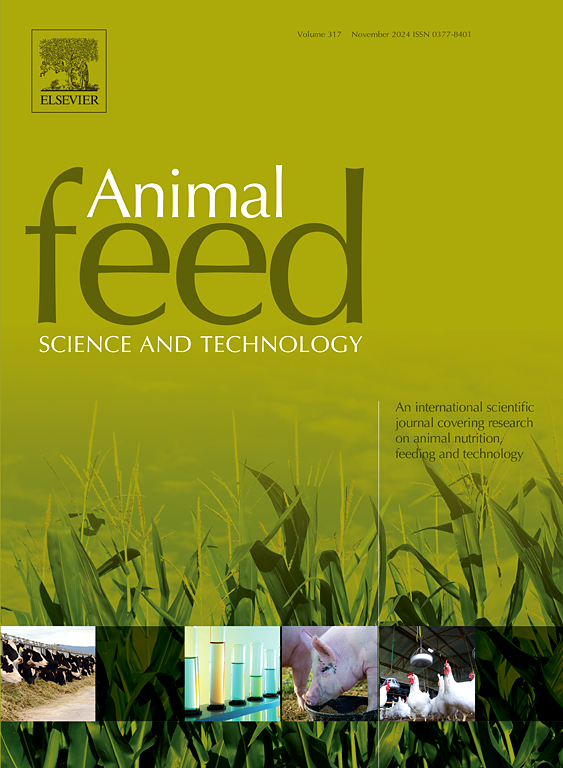In vitro rumen degradation, fermentation, and methane production of four agro-industrial protein-rich co-products, compared with soyabean meal
IF 2.5
2区 农林科学
Q1 AGRICULTURE, DAIRY & ANIMAL SCIENCE
引用次数: 0
Abstract
Soyabean is considered an unsustainable protein source for livestock feeds because of the large quantity of input and energy required to cultivate and process it. Other protein-based agro-industrial co-products that are less input-intensive, can mitigate methane (CH4) production and may therefore be more sustainable options instead soyabean. The objective of this study was to compare the effect of replacing the same amount of protein (40 g/kg DM crude protein) as soyabean meal (SBM) with low-carbon local agro-industrial co-products, (brewers’ spent grains, BSG; dried wheat distillers’ grains, WDG; dried corn distillers’ grains, CDG and corn steep liquor CSL), on in vitro rumen degradation, fermentation and gas and methane production. The study used a 72-hour in vitro gas production method with a basal substrate of dried, ground grass silage and wheat. Gas volumes were measured at ten different specific intervals, and CH4 concentrations were analysed via gas chromatography. After 72 hours, in vitro DM degradability (IVDMD) and volatile fatty acid (VFA) concentrations were assessed. Gas and CH4 production curve profiles were fitted to models to determine asymptote production, the extent of degradation in rumen proper (RoP), and the fractional degradation rate (μ) (h−1) in the halfway 50 % of the asymptote production. The IVDMD and estimated RoP at 0.04 h and 0.025 h were lower (P<0.05) for BSG compared to the other treatments, by 4.9-6.6 %; 5.8–9.9 %; 5.2–9.0 %. Gas and CH4 yield (mL/g substrate and mL/g substrate degraded), and pH (SB = 6.77, BSG = 6.80, WDG = 6.74, CDG = 6.84, and CSL = 6.73; P>0.05), were not significantly affected by treatment. Butyrate and valerate were lower (P<0.05) for BSG compared to CSL, and caproate was lower (P<0.001) for BSG compared to the other treatments and in CSL compared to SBM. The results regarding degradability and VFAs concentrations of this study demonstrated that dried wheat distillers’ grains, dried corn distillers’ grains, and corn steep liquor have the potential to replace soyabean meal as protein sources for ruminants, but further reduction of CH4 emissions as a result of such practice may not be expected. Although slightly less degradable, based on their nutrient composition and the fact they did not affect rumen fermentation characteristics, brewers' spent grains can still play a complementary role in ruminant diets, especially in regions where they are locally readily available.
四种富含蛋白质的农工副产品与大豆粕的体外瘤胃降解、发酵和甲烷产生量比较
大豆被认为是不可持续的牲畜饲料蛋白质来源,因为种植和加工大豆需要大量的投入和能源。其他以蛋白质为基础的农工副产品的投入密集度较低,可以减少甲烷(CH4)的产生,因此可能比大豆更具有可持续性。本研究的目的是比较用当地低碳农工副产品(酿酒乏谷 BSG、干小麦蒸馏谷 WDG、干玉米蒸馏谷 CDG 和玉米浸出液 CSL)替代等量蛋白质(40 克/千克 DM 粗蛋白质)的大豆粉(SBM)对体外瘤胃降解、发酵、气体和甲烷产生的影响。该研究采用 72 小时体外产气法,以干燥、磨碎的青草青贮和小麦为基质。在十个不同的特定时间间隔测量气体量,并通过气相色谱法分析甲烷浓度。72 小时后,评估体外 DM 降解性(IVDMD)和挥发性脂肪酸(VFA)浓度。将气体和甲烷产量曲线拟合到模型中,以确定渐近线产量、瘤胃内的降解程度(RoP)以及渐近线产量一半的降解率(μ)(h-1)。与其他处理相比,BSG 在 0.04 h 和 0.025 h 的 IVDMD 和估计 RoP 分别低 4.9-6.6 %、5.8-9.9 %、5.2-9.0 %(P<0.05)。气体和甲烷产量(毫升/克基质和毫升/克基质降解量)以及 pH 值(SB = 6.77、BSG = 6.80、WDG = 6.74、CDG = 6.84 和 CSL = 6.73;P>0.05)受处理的影响不大。与 CSL 相比,BSG 的丁酸盐和戊酸盐含量较低(P<0.05),与其他处理相比,BSG 的己酸盐含量较低(P<0.001),与 SBM 相比,CSL 的己酸盐含量较低。本研究有关降解性和 VFAs 浓度的结果表明,干小麦蒸馏谷物、干玉米蒸馏谷物和玉米浸出液有可能取代大豆粉作为反刍动物的蛋白质来源,但预计这种做法不会进一步减少 CH4 排放。虽然啤酒糟的降解性稍差,但基于其营养成分和不影响瘤胃发酵特性的事实,啤酒糟仍可在反刍动物日粮中发挥补充作用,尤其是在当地容易获得啤酒糟的地区。
本文章由计算机程序翻译,如有差异,请以英文原文为准。
求助全文
约1分钟内获得全文
求助全文
来源期刊

Animal Feed Science and Technology
农林科学-奶制品与动物科学
CiteScore
6.00
自引率
6.20%
发文量
266
审稿时长
3 months
期刊介绍:
Animal Feed Science and Technology is a unique journal publishing scientific papers of international interest focusing on animal feeds and their feeding.
Papers describing research on feed for ruminants and non-ruminants, including poultry, horses, companion animals and aquatic animals, are welcome.
The journal covers the following areas:
Nutritive value of feeds (e.g., assessment, improvement)
Methods of conserving and processing feeds that affect their nutritional value
Agronomic and climatic factors influencing the nutritive value of feeds
Utilization of feeds and the improvement of such
Metabolic, production, reproduction and health responses, as well as potential environmental impacts, of diet inputs and feed technologies (e.g., feeds, feed additives, feed components, mycotoxins)
Mathematical models relating directly to animal-feed interactions
Analytical and experimental methods for feed evaluation
Environmental impacts of feed technologies in animal production.
 求助内容:
求助内容: 应助结果提醒方式:
应助结果提醒方式:


